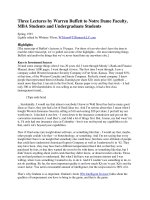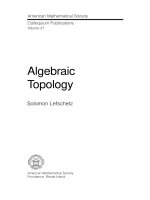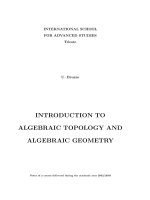Algebraic topology class notes lectures by denis sjerve, notes by benjamin young
Bạn đang xem bản rút gọn của tài liệu. Xem và tải ngay bản đầy đủ của tài liệu tại đây (622.54 KB, 119 trang )
Math 528: Algebraic Topology Class Notes
Lectures by Denis Sjerve, notes by Benjamin Young
Term 2, Spring 2005
2
www.pdfgrip.com
Contents
1 January 4
1.1
9
A Rough Definition of Algebraic Topology . . . . . . . . . . .
2 January 6
9
15
2.1
The Mayer-Vietoris Sequence in Homology . . . . . . . . . . . 15
2.2
Example: Two Spaces with Identical Homology . . . . . . . . 20
3 January 11
23
3.1
Hatcher’s Web Page
. . . . . . . . . . . . . . . . . . . . . . . 23
3.2
CW Complexes . . . . . . . . . . . . . . . . . . . . . . . . . . 23
3.3
Cellular Homology . . . . . . . . . . . . . . . . . . . . . . . . 26
3.4
A Preview of the Cohomology Ring . . . . . . . . . . . . . . . 28
3.5
Boundary Operators in Cellular Homology . . . . . . . . . . . 28
4 January 13
31
3
www.pdfgrip.com
4
CONTENTS
4.1 Homology of RP n . . . . . . . . . . . . . . . . . . . . . . . . . 31
4.2 A Pair of Adjoint Functors . . . . . . . . . . . . . . . . . . . . 33
5 January 18
35
5.1 Assignment 1 . . . . . . . . . . . . . . . . . . . . . . . . . . . 35
5.2 Homology with Coefficients
. . . . . . . . . . . . . . . . . . . 36
5.3 Application: Lefschetz Fixed Point Theorem . . . . . . . . . . 38
6 January 20
43
6.1 Tensor Products . . . . . . . . . . . . . . . . . . . . . . . . . . 43
6.2 Lefschetz Fixed Point Theorem . . . . . . . . . . . . . . . . . 45
6.3 Cohomology . . . . . . . . . . . . . . . . . . . . . . . . . . . . 47
7 January 25
49
7.1 Examples: Lefschetz Fixed Point Formula . . . . . . . . . . . 49
7.2 Applying Cohomology . . . . . . . . . . . . . . . . . . . . . . 53
7.3 History: The Hopf Invariant 1 Problem . . . . . . . . . . . . . 53
7.4 Axiomatic Description of Cohomology
. . . . . . . . . . . . . 55
7.5 My Project . . . . . . . . . . . . . . . . . . . . . . . . . . . . 55
8 January 27
57
www.pdfgrip.com
CONTENTS
5
8.1
A Difference Between Homology and Cohomology . . . . . . . 57
8.2
Axioms for Unreduced Cohomology . . . . . . . . . . . . . . . 57
8.3
Eilenberg-Steenrod Axioms . . . . . . . . . . . . . . . . . . . . 58
8.4
Construction of a Cohomology Theory . . . . . . . . . . . . . 59
8.5
Universal Coefficient Theorem in Cohomology . . . . . . . . . 62
9 February 1
65
9.1
Comments on the Assignment . . . . . . . . . . . . . . . . . . 65
9.2
Proof of the UCT in Cohomology . . . . . . . . . . . . . . . . 67
9.3
Properties of Ext(A, G) . . . . . . . . . . . . . . . . . . . . . 69
10 February 3
71
10.1 Naturality in the UCT . . . . . . . . . . . . . . . . . . . . . . 71
10.2 Proof of the UCT . . . . . . . . . . . . . . . . . . . . . . . . . 72
10.3 Some Homological Algebra . . . . . . . . . . . . . . . . . . . . 73
10.4 Group Homology and Cohomology . . . . . . . . . . . . . . . 75
10.5 The Milnor Construction . . . . . . . . . . . . . . . . . . . . . 77
11 February 8
81
11.1 A Seminar by Joseph Maher . . . . . . . . . . . . . . . . . . . 81
11.2 Products . . . . . . . . . . . . . . . . . . . . . . . . . . . . . . 82
www.pdfgrip.com
6
CONTENTS
12 February 23
87
12.1 Assignment 2 . . . . . . . . . . . . . . . . . . . . . . . . . . . 87
12.2 Examples of computing cohomology rings . . . . . . . . . . . . 88
12.3 Cohomology Operations . . . . . . . . . . . . . . . . . . . . . 91
12.4 Axioms for the mod 2 Steenrod Algebra . . . . . . . . . . . . 92
13 February 25
95
13.1 Axiomatic development of Steenrod Algebra . . . . . . . . . . 95
13.2 Application: Hopf invariant 1 problem . . . . . . . . . . . . . 97
13.3 Poincar´e Duality . . . . . . . . . . . . . . . . . . . . . . . . . 98
13.4 Orientability . . . . . . . . . . . . . . . . . . . . . . . . . . . . 99
14 March 1
101
14.1 Last time . . . . . . . . . . . . . . . . . . . . . . . . . . . . . 101
14.2 Orientable coverings . . . . . . . . . . . . . . . . . . . . . . . 102
14.3 Other ways of defining orientability . . . . . . . . . . . . . . . 103
14.4 Poincar´e Duality . . . . . . . . . . . . . . . . . . . . . . . . . 106
14.5 Reading: Chapter 4, Higher homotopy groups . . . . . . . . . 106
15 March 3
109
15.1 The path-loop fibration . . . . . . . . . . . . . . . . . . . . . . 109
www.pdfgrip.com
CONTENTS
7
15.2 The James Reduced Product Construction JX . . . . . . . . . 111
15.3 The Infinite Symmetric Product SP ∞ (X) . . . . . . . . . . . 112
15.4 Higher Homotopy Groups . . . . . . . . . . . . . . . . . . . . 113
16 March 8
115
16.1 More on the Milnor Simplicial Path Loop Spaces . . . . . . . . 115
16.2 Relative Homotopy Groups . . . . . . . . . . . . . . . . . . . . 117
www.pdfgrip.com
8
CONTENTS
www.pdfgrip.com
Chapter 1
January 4
1.1
A Rough Definition of Algebraic Topology
Algebraic topology is a formal procedure for encompassing all functorial relationships between the worlds of topology and algebra:
F
world of topological problems −→ world of algebraic problems
Examples:
1. The retraction problem: Suppose X is a topological space and A ⊆ X
is a subspace. Does there exist a continuous map r : X → A such that
r(a) = a for all a ∈ A? r is called a retraction and A is called a retract
of X. If a retraction ∃ then we have a factorization of the identity map
i
r
on A : A → X → A, where r ◦ i = idA .
F (i)
F (r)
Functoriality of F means that the composite F (A) → F (X) → F (A)
F (r)
F (i)
(respectively F (A) → F (X) → F (A)) is the identity on F (A) if F is a
9
www.pdfgrip.com
10
CHAPTER 1. JANUARY 4
covariant (respectively contravariant) functor. As an example consider
the retraction problem for X the n-disk and A its boundary, n > 1 :
r
i
S n−1 = ∂(D n ) → D n → ∂(D n ) = S n−1.
Suppose that the functor F is the nth homology group:
i
r
∗
∗
Hn−1 (D n ) →
Hn−1 (∂(D n )) →
||
Z
Hn−1 (∂D n )
||
i
∗
−→
||
r
∗
−→
0
Z
Such a factorization is clearly not possible, so ∂D n is not a retract of
Dn
2. When does a self map f : X → X have a fixed point? That is, when
does ∃ x ∈ X such that f (x) = x? For example suppose f : X → X,
where X = D n . Assume that f (x) = x for all x ∈ D n . Then we can
project f (x) through x onto a point r(x) ∈ ∂D n , as follows:
r(x)
x
f (x)
Dn
Then r : Dn → ∂D n is continuous and r(x) = x if x ∈ ∂D n . Thus r
is a retraction of D n onto its boundary, a contradiction. Thus f must
have a fixed point.
3. What finite groups G admit fixed point free actions on some sphere
S n ? That is, when does ∃ a map G × S n → S n , (g, x) → g · x, such
that h · (g · x) = (hg) · x, id · x = x, and for any g = id, g · x = x for
all x ∈ S n .
www.pdfgrip.com
1.1. A ROUGH DEFINITION OF ALGEBRAIC TOPOLOGY
11
This is “still” unsolved (although some of the ideas involved in the
supposed proof of the Poincar´e conjecture would do it for dimension
3). However, lots is known about this problem.
For example, any cyclic group G = Zn admits a fixed-point free action
on any odd-dimensional sphere:
S 2k−1 = {(z1 , . . . , zk ) ⊆ Ck |
zi z¯i = 1}.
A generator for G is T : S 1 → S 1 , T (x) = ξx, where ξ = e2πi/n . Then
a fixed point free action of G on S 2k−1 is given by
T (z1 , . . . , zk ) = (ξz1 , . . . , ξzk ).
There are other actions as well.
Exercise: Construct some other fixed point free actions of G on S 2k−1 .
4. Suppose M n is a smooth manifold of dimension n. What is the span of
M, that is what is the largest integer k such that there exists a k-plane
varing continuously with respect to x? This means that at each point
x ∈ M we have k linearly independent tangent vectors v1 (x), . . . , vk (x)
in Tx M, varying continuously with respect to x.
$x$
Tx (M)
Definition: if k = n then we say that M is parallelizable.
In all cases k ≤ n.
In the case of the 2-sphere we can’t find a non-zero tangent vector
which varies continuously over the sphere, so k = 0. This is the famous
“fuzzy ball” theorem. On the other hand S 1 is parallelizable.
www.pdfgrip.com
12
CHAPTER 1. JANUARY 4
S 3 is also parallizable. To see this consider R4 with basis the unit
quaternions 1, i, j, k. Thus a typical quaternion is q = q0 +q1 i+q2 j+q3 k,
where the qi are real. R4 becomes a division algebra, where we multiply
quaternions using the rules
i2 = j 2 = k 2 = −1, ij = k, ji = −k, jk = i, kj = −i, ki = j, ik = −j
and the distributive law. That is
qq = (q0 + q1 i + q2 j + q3 k)(q0 + q1 i + q2 j + q3 k) = r0 + r1 i + r2 j + r3 k
where
r0
r1
r2
r3
=
=
=
=
q0 q0 − q1 q1 − q2 q2 − q3 q3
q0 q1 + q1 q0 + q2 q3 − q3 q2
q0 q2 − q1 q3 + q2 q0 + q3 q1
q0 q3 + q1 q2 − q2 q1 + q3 q0
The conjugate of a quaternion q = q0 + q1 i + q2 j + q3 k is defined by
q¯ = q0 − q1 i − q2 j − q3 . It is routine to show that q q¯ = n qn2 . We define
√
the norm of a quaternion by |q| = q q¯. Then |qq | = |q|||q |
The space of unit quaternions
{q0 + q1 i + q2 j + q3 k|
qn2 = 1}
n
is just the 3-sphere, and it is a group. Pick three linearly independent
vectors at some fixed point in S 3 . Then use the group structure to
translate this frame to all of S 3 .
www.pdfgrip.com
1.1. A ROUGH DEFINITION OF ALGEBRAIC TOPOLOGY
13
5. The homeomorphism problem. When is X homeomorphic to Y ?
X
f
−−−→
F
F
Y
F (f )
F (x) −−−→ F (Y )
6. The homotopy equivalence problem. When is X homotopically equivalent to Y ?
f
p
7. The lifting problem. Given X → B and E → b, can we find a map
f˜ : X → E such that pf˜ f ?
8. The embedding problem for manifolds. What is the smallest k such
that the n-dimensional manifold M can be embedded into Rn+k ?
Let S n be the unit sphere in Rn+1 and RP n = real projective space of
dimension n:
def
RP n = S n /x ∼ −x.
Alternatively, RP n is the space of lines through the origin in Rn+1 .
Unsolved problem: what is the smallest k such that RP n ⊆ Rn+k ?
9. Immersion problem: What is the least k such that RP n immerses into
Rn+k ?
embedding
$S^1$
R^2
immersion
www.pdfgrip.com
14
CHAPTER 1. JANUARY 4
10. The computation of homotopy groups of spheres.
def
πk (X) = the set of homotopy classes of maps f : S k → X.
It is known that πk (X) is a group ∀ k ≥ 1 and that πk (X) is abelian
∀k ≥ 2. What is πk (S n )? The Freudenthal suspension theorem states
that πk (S n ) ≈ πk+1 (S n+1) if k < 2n − 1. For example,
π4 (S 3 ) ≈ π5 (S 4 ) ≈ π6 (S 5 ) ≈ · · · .
We know that these groups are all ≈ Z2 and π3 (S 2 ) = Z.
www.pdfgrip.com
Chapter 2
January 6
2.1
The Mayer-Vietoris Sequence in Homology
Recall the van Kampen Theorem: Suppose X is a space with a base point
x0 , and X1 and X2 are path connected subspaces such that x0 ∈ X1 ∩ X2 ,
X = X1 ∪ X2 and X1 ∩ X2 is path connected. Consider the diagram
i
1
X1 ∩ X2 −−−
→ X1
j
i
1
2
X2
j2
−−−→ X
Apply the fundamental group ‘functor’ π1 to this diagram:
15
www.pdfgrip.com
16
CHAPTER 2. JANUARY 6
i1#
π1 (X1 ∩ X2 ) −−−→ π1 (X1 )
i
j
2#
π1 (X2 )
1#
j2#
−−−→ π1 (X)
Question: How do we compute π1 (X) from this data?
There exists a group homomorphism from the free product π1 (X1 ) ∗ π1 (X2 )
into π1 (X), given by c1 · c2 → j1# (c1 ) · j2# (c2 ).
Fact: This map is onto π1 (X). However, there exists a kernel coming from
π1 (X1 ∩ X2 ). In fact, i1# (α) · i2# (α−1 ), for every α ∈ π1 (X1 ∩ X2 ), is in the
kernel because j1# i1# = j2# i2# .
Theorem: (van Kampen): Suppose all the spaces X1 , X2 , X1 ∩ X2 contain
the base point x0 ∈ X = X1 ∪ X2 , and every space is path connected. Then
π1 (X) ≈ π1 (X1 ) ∗ π2 (X2 )/K where K is the normal subgroup generated by
all elements of the form i1# (α) · i2# (α−1 ), where α ∈ Π2 (X1 ∩ X2 ).
Definition: Let X be a space with a base point x0 ∈ X. The nth homotopoy
group is the set of all homotopy classes of maps f : (I n , ∂I n ) → (X, x0 ). Here,
I n = {(t1 , . . . , tn )|0 ≤ ti ≤ 1};
∂I n = the boundary of I n
= {(t1 , . . . , tn ) | 0 ≤ ti ≤ 1, some ti = 0 or 1}
Notation: πn (X, x0 ) = πn (X) = the nth homotopy group.
Fact: I n /∂I n ≈ S n . Therefore, Πn (X) consists of the homotopy classes of
maps f : (S n , ∗) → (X, x0 ).
Question: Is there a van Kampen theorem for Πn ?
Answer: NO.
But there is an analogue of the van Kampen Theorem in Homology: it is the
www.pdfgrip.com
2.1. THE MAYER-VIETORIS SEQUENCE IN HOMOLOGY
17
Meyer–Vietoris sequence. Here is the setup:
i
1
X1 ∩ X2 −−−
→
i
X1
j
1
2
j2
−−−→ X = X1 ∪ X2
X2
Question: What is the relationship amongst H∗ (X1 ∩ X2 ), H∗ (X1 ), H∗ (X2 )
and H∗ (X)?
Theorem: (Mayer-Vietoris) Assuming some mild hypotheses on X1 , X2 , X
there exists a long exact sequence:
β∗
α
∂
· · · → Hn (X1 ∩ X2 ) →∗ Hn (X1 ) ⊕ Hn (X2 ) → Hn (X) →
α
Hn−1 (X1 ∩ X2 ) →∗ · · · → H0 (X) → 0.
The maps α∗ and β∗ are defined by
β∗ : Hn (X1 ) ⊕ Hn (X2 ) → Hn (X), β∗ (c1 , c2 ) → j1∗ (c1 ) + j2∗ (c2 )
α∗ : Hn (X1 ∩ X2 ) → Hn (X1 ) ⊕ Hn (X2 ), c → (i1# (c), −i2# (c))
The minus sign gets included in α∗ for the purpose of making things exact
(so that β∗ α∗ = 0). One could have included it in the definition of β∗ instead
and still be correct.
Proof: There exists a short exact sequence of chain complexes
β
α
0 → C∗ (X1 ∩ X0 ) → C∗ (X1 ) ⊕ C∗ (X2 ) → C∗ (X1 + X2 ) → 0
where Cn (X1 + X2 ) is the group of chains of the form c1 + c2 , where c1
comes from X1 and c2 comes from X2 . The ‘mild hypotheses’ imply that the
inclusion C∗ (X1 + X2 ) ⊆ C∗ (X) is a chain equivalence.
Lemma: If
α
β
0→C →C →C→0
www.pdfgrip.com
18
CHAPTER 2. JANUARY 6
is an exact sequence of chain complexes, then there exists a long exact sequence
α
β∗
∂
α
· · · → Hn (C ) →∗ Hn (C ) → Hn (C) → Hn−1 (C ) →∗ · · ·
To prove this, one uses the “snake lemma” which may be found in Hatcher,
or probably in most homological algebra references.
Remarks: There exists a Mayer-Vietoris sequence for reduced homology, as
well:
α
β∗
∂
α
˜ n (X1 ∩ X2 ) →∗ H
˜ n (X1 ) ⊕ H
˜ n (X2 ) → H
˜ n (x) → H
˜ n−1 (X1 ∩ X2 ) →∗ · · ·
··· → H
˜ n def
= Hn (X, x0 ). Therefore
The reduced homology groups are defined by H
˜ n (X) for n = 0 and H0 (X) ≈ H
˜ 0 (X) ⊕ Z.
Hn (X) ≈ H
Examples. The unreduced suspension of a space X is
SX := X × [0, 1]/(x × 0 = p, x × 1 = q, ∀x ∈ X)
single point q
t=1
I
t=0
single point p
We also have the reduced suspension for a space X with a base point x0 :
ΣX = SX/(x0 × [0, 1])
www.pdfgrip.com
2.1. THE MAYER-VIETORIS SEQUENCE IN HOMOLOGY
19
q
x0
x0
p
Fact: Suppose A ⊆ W is a contractible subspace. Then, assuming certain
mild hypotheses, W → W/A is a homotopy equivalence.
≈ ˜
˜ n (SX) →
Corollary: H
Hn−1 (X).
Proof:
cone C+
X(t = 12 )
SX =
cone C−
Consider the Mayer-Vietoris sequence for the pair (C+ , C− ):
β∗
α∗ ˜
δ ˜
α
˜ n (X) →
˜ n (C− ) →
˜ n (SX) →
··· → H
Hn (C+ ) ⊕ H
H
Hn−1 (X) →∗ · · ·
=0
=0
www.pdfgrip.com
20
CHAPTER 2. JANUARY 6
˜ n (S k ) ∼ H
˜ n−1 (S k−1).
Corollary H
Pf. S(S k−1 ) = S k .
2.2
Example: Two Spaces with Identical Homology
Recall that real projective n-space is RP n = S n /(x ∼ −x), the n-sphere with
antipodal points identified. Let us write S 2 (RP 2 ) for S(S(RP 2 )). Define
def
X = RP 2 ∨ S 2 (RP 2 )
def
Y = RP 4,
where A ∨ B is the one point union of A, B. Now,
Z if i = 0
4
Hi (Y ) = Hi (RP ) = Z2 if i = 1, 3
0
otherwise.
˜ i (A ∨ B) ≈ H
˜ i (A) ⊕ H
˜ i (B) using an appropriate
Exercise Show that H
Mayer-Vietoris sequence.
So we can compute that
Z
2
2
2
Hi (X) = Hi (RP ∨ S (RP )) = Z2
0
if i = 0
if i = 1, 3
otherwise,
which is the same homology as Y .
Is it the case that X and Y are “the same” in some sense? Perhaps “same”
means “homeomorphic”? But Y = RP 4 is a 4–dimensional manifold, whereas
X = RP 2 ∨ S 2 (RP 2 ) is not a manifold. So X is not homeomorphic to Y .
www.pdfgrip.com
2.2. EXAMPLE: TWO SPACES WITH IDENTICAL HOMOLOGY
21
Can “same” mean “homotopy equivalent?” Still no. The universal covering
space of Y is S 4 , whereas the universal covering space of X is:
copy of S 2 (RP 2 )
S 2 =universal covering space of RP 2
copy of S 2 (RP 2 )
If X and Y were homotopically equivalent then their universal covering spaces
˜ and Y˜ be the universal covwould also be homotopically equivalent. Let X
˜
ering space. Then H2 (X) = Z ⊕ Z ⊕ Z, but H2 (Y˜ ) = 0.
Question: Does there exist a map f : X → Y (or g : Y → X) such that f∗
(resp, g∗ ) is an isomorphism in homology?
Again, the answer is no, and we shall see why next week.
www.pdfgrip.com
22
CHAPTER 2. JANUARY 6
www.pdfgrip.com
Chapter 3
January 11
3.1
Hatcher’s Web Page
Hatcher’s web page is: There,
you can find an electronic copy of the text.
3.2
CW Complexes
The fundamental construction is attaching an n-cell en to a space A. Suppose
we have a map φ : S n−1 → A. In general we can’t extend this to a map
Φ
D n → A, but we can extend it if we enlarge the space A to X, where
X=A
D n /(φ(x) ∼ x ∀x ∈ ∂D n = S n−1.
23
www.pdfgrip.com
24
CHAPTER 3. JANUARY 11
en
φ
A
Dn
S n−1
We say that X is obtained from A by attaching an n-cell en . The given map
φ : S n−1 → A is the sattaching map and its extension Φ : D n → X is called
the characteristic map.
Definition: of a CW complex: X = X 0 ∪ X 1 ∪ · · ·
Start with a discrete set of points X 0 = {x1 , x2 , . . .}. Now attach 1-cells via
maps φα : S 0 → X 0 , where α ∈ A = some index set.
X 1 is the result of attaching 1-cells.
eα
x3
x1
x4
x2
Suppose we have constructed X n−1 , the (n − 1)-skeleton. Then X n is the
result of attaching n-cells to X n−1 by maps φβ : S n−1 → X n−1, β ∈ B:
X n := X n−1
β∈B
Dβn
(x ∼ φβ (x), ∀x ∈ ∂Dβn and β ∈ B)
Examples.
www.pdfgrip.com
3.2. CW COMPLEXES
25
1. X = S n = pt ∪en = e0 ∪en . A = pt = e0 . φ : S n−1 → A is the constant
map. Thus, X = A D n x ∈ ∂D n , x ∼ e0 . Thus X is the n-sphere S n .
2. S n = ∂(∆n+1 ), where ∆n+1 is the standard n+1-simplex. For example,
the surface of the tetrahedron is ∂(∆3 ) = S 2 . To describe S 2 this way
(as a simplicial complex) we need: 4 vertices, 6 edges and 4 faces. This
is far less efficient than the CW-complex description above.
3. RP n := the space of lines through the origin in Rn+1 = S n (x ∼ −x).
We can think of a point in RP n as a pair of points {x, −x}, x ∈ S n .
n
C + = D+
−x
x
n
C − = D−
There is a double covering φ : S n → RP n−1 , where φ(x) = (x, −x),
and RP n = RP n−1 ∪φ en . Therefore RP n has a cell decomposition of
the form RP n = e0 ∪ e1 ∪ · · · ∪ en .
4. CP n , complex projective n-space, is the space of one-dimensional compex subvector spaces of Cn+1 . It is homeomorphic to the quotient space
S 2n+1 (x ∼ ζx, ∀ x ∈ S 2n+1 and all unit complex numbers ζ).
Here is another way to describe CP n : there exists an action of S 1 on
S 2n+1 . Let us think of S 2n+1 in the following way:
S 2n+1 = {(z1 , . . . , zn+1 ) | z1 z¯1 + · · · + zn+1 z¯n+1 = 1}.
www.pdfgrip.com









